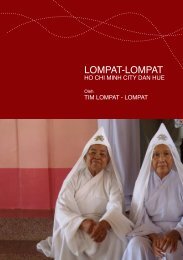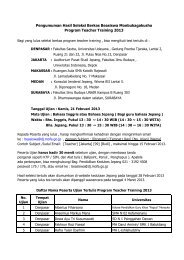9700_y16_sy
9700_y16_sy
9700_y16_sy
You also want an ePaper? Increase the reach of your titles
YUMPU automatically turns print PDFs into web optimized ePapers that Google loves.
Cambridge International AS and A Level Biology <strong>9700</strong> <strong>sy</strong>llabus Syllabus content<br />
18 Biodiversity, classification and conservation<br />
The biodiversity of the Earth is threatened by human activities and climate change. Classification <strong>sy</strong>stems<br />
attempt to put order on the chaos of all the organisms that exist on Earth. Field work is an important part<br />
of a biological education to appreciate this diversity and find out how to analyse it. There are opportunities<br />
in this section for candidates to observe different species in their locality and assess species distribution<br />
and abundance. Conserving biodiversity is a difficult task but is achieved by individuals, local groups,<br />
national and international organisations. Candidates should appreciate the threats to biodiversity and<br />
consider the steps taken in conservation, both locally and globally.<br />
Candidates will be expected to use the knowledge gained in this section to solve problems in familiar and<br />
unfamiliar contexts.<br />
Learning outcomes<br />
Candidates should be able to:<br />
18.1 Biodiversity<br />
Biodiversity is much more than<br />
a list of all the species in a<br />
particular area.<br />
a) define the terms species, eco<strong>sy</strong>stem and niche<br />
b) explain that biodiversity is considered at three different levels:<br />
• variation in eco<strong>sy</strong>stems or habitats<br />
• the number of species and their relative abundance<br />
• genetic variation within each species<br />
c) explain the importance of random sampling in determining the<br />
biodiversity of an area<br />
d) use suitable methods, such as frame quadrats, line transects,<br />
belt transects and mark-release-recapture, to assess the<br />
distribution and abundance of organisms in a local area<br />
e) use Spearman’s rank correlation and Pearson’s linear<br />
correlation to analyse the relationships between the<br />
distribution and abundance of species and abiotic or biotic<br />
factors<br />
f) use Simpson’s Index of Diversity (D) to calculate the<br />
n 2<br />
biodiversity of a habitat, using the formula D = 1–<br />
NΣN NO<br />
O<br />
and<br />
state the significance of different values of D<br />
18.2 Classification<br />
Organisms studied locally<br />
may be used to show how<br />
hierarchical classification<br />
<strong>sy</strong>stems are organised.<br />
a) describe the classification of species into the taxonomic<br />
hierarchy of domain, kingdom, phylum, class, order, family,<br />
genus and species<br />
b) outline the characteristic features of the three domains<br />
Archaea, Bacteria and Eukarya<br />
c) outline the characteristic features of the kingdoms Protoctista,<br />
Fungi, Plantae and Animalia<br />
d) explain why viruses are not included in the three domain<br />
classification and outline how they are classified, limited to<br />
type of nucleic acid (RNA or DNA) and whether these are<br />
single stranded or double stranded<br />
Back to contents page<br />
www.cie.org.uk/alevel<br />
43





